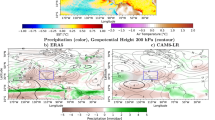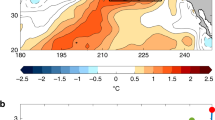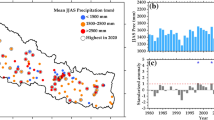Abstract
During austral summers (DJF) 1934/35, 2017/18 and 2018/19, the New Zealand (NZ) region (approximately 4 million km2) experienced the most intense coupled ocean-atmosphere heatwaves on record. Average air temperature anomalies over land were + 1.7 to 2.1 °C while sea surface temperatures (SST) were 1.2 to 1.9 °C above average. All three heatwaves exhibited maximum SST anomalies west of the South Island of NZ. Atmospheric circulation anomalies showed a pattern of blocking centred over the Tasman Sea extending south-east of NZ, accompanied by strongly positive Southern Annular Mode conditions, and reduced trough activity over NZ. Rapid melt of seasonal snow occurred in all three cases. For the two most recent events, combined ice loss in the Southern Alps was estimated at 8.9 km3 (22% of the 2017 volume). Sauvignon blanc and Pinot noir wine grapes had above average berry number and bunch mass in 2018 but were below average in 2019. Summerfruit harvest (cherries and apricots) was 14 and 2 days ahead of normal in 2017/18 and 2018/19 respectively. Spring wheat simulations suggested earlier flowering and lower grain yields compared to average, and below-average yield and tuber quality in potatoes crops occurred. Major species disruption occurred in marine ecosystems. Hindcasts indicate that the heatwaves were either atmospherically driven or arose from combinations of atmospheric surface warming and oceanic heat advection.








Similar content being viewed by others
References
Arblaster JM, Meehl GA, Karoly DJ (2011) Future climate change in the southern hemisphere: competing effects of ozone and greenhouse gases. Geophys Res Lett 38(2). https://doi.org/10.1029/2010GL045384
Behrens E, Fernandez D, Sutton P (2019) Meridional oceanic heat transport influences marine heatwaves in the Tasman Sea on interannual to decadal timescales. Front Mar Sciee 6:228. https://doi.org/10.3389/fmars.2019.00228
Benthuysen J, Feng M, Zhong L (2014) Spatial patterns of warming off Western Australia during the 2011 Ningaloo Nino: quantifying impacts of remote and local forcing Cont. Shelf Res 91:232–246. https://doi.org/10.1016/j.csr.2014.09.014
Blunden J, Arndt DS (2019) A look at 2018 takeaway points from the state of the climate 2018 supplement. Bull Amer Met Soc 2019:1527–1538. https://doi.org/10.1175/BAMS-D-19-0193.1
Chinn TJ (2001) Distribution of the glacial water resources of New Zealand. J Hydrol N Z 40(2):139–187 https://www.jstor.org/stable/43922047
Chinn TJ, Fitzharris BB, Salinger MJ, Willsman A (2012) Annual ice volume changes 1976–2008 for the New Zealand Southern Alps. Glob Planet Change 92–93:105–118. https://doi.org/10.1016/j.gloplacha.2012.04.002
Compo GP, Whitaker JS, Sardeshmukh PD, Matsui N, Allan RJ, Yin X et al (2011) The twentieth century reanalysis project. Q J R Meteorol Soc 137(654):1–28. https://doi.org/10.1002/qj.776
de Lautour S (1999) The climatology of seasonal snow. MSc Thesis, Department of Geography, University of Otago
Dee DP, Uppala SM, Simmons AJ, Berrisford P, Poli P, Kobayashi S et al (2011) The ERA-interim reanalysis: configuration and performance of the data assimilation system. Q J R Meteorol Soc 137(656):553–597. https://doi.org/10.1002/qj.828
Fitzharris B, Garr GE (1995) Simulation of past variability in seasonal snow in the southern Alps, New Zealand. Ann Glaciol 21:377–382. https://doi.org/10.3189/S0260305500016098
Fogt RL, Perlwitz J, Monaghan AJ, Bromwich DH, Jones JM, Marshall GJ (2009) Historical SAM variability. Part II: twentieth-century variability and trends from reconstructions, observations, and the IPCC AR4 models. J Clim 22:5346–5365. https://doi.org/10.1175/2009JCLI2786.1
Garr CE, Fitzharris BB (1996) Using seasonal snow to forecast inflows into South island hydro lakes. In: Prospects and Needs for Climate Forecasting, The Royal Society of New Zealand Miscellaneous Series 34: 63–67 [ISBN 0-908654-61-8]
Gordon ND (1986) The southern oscillation and New Zealand weather. Mon Weather Rev 114:371–387. https://doi.org/10.1175/1520-0493(1986)114<0371:TSOANZ>2.0.CO;2
Greer DH, Weston C (2010) Heat stress affects flowering, berry growth, sugar accumulation and photosynthesis of *Vitis vinifera* cv. Semillon grapevines grown in a controlled environment. Funct Plant Biol 37:206–214. https://doi.org/10.1071/FP09209
Gregan P (2019) Vintage 2019 small but stunning. https://www.nzwine.com/media/13040/vintage-2019-small-but-stunning.pdf
Hartmann DL, AMG KT, Rusticucci M, Alexander LV, Brönnimann S, Charabi Y, Dentener FJ, Dlugokencky EG, Easterling DR, Kaplan A, Soden BJ, Thorne PW, Wild M, Zhai PM (2013) Observations: atmosphere and surface. In: Stocker TF, Qin D, Plattner K-G, Tignor M, Allen SK, Boschung J, Nauels A, Xia Y, Bex V, Midgley PM (eds) Climate Change 2013: The Physical Science Basis. Contribution of Working Group I to the Fifth Assessment Report of the Intergovernmental Panel on Climate Change. Cambridge University Press, Cambridge
Heidemann H, Ribbe J (2019) Marine heat waves and the influence of El Niño off Southeast Queensland, Australia, Frontiers of marine science, 20 February 2019. https://doi.org/10.3389/fmars.2019.0005d
Henley BJ, Gergis J, Karoly DJ, Power SB, Kennedy J, Folland CK (2015) A tripole index for the Interdecadal Pacific Oscillation. Clim Dyn 45(11–12):3077–3090. https://doi.org/10.1007/s00382-015-2525-1 Accessed on 05 27 2019 at https://www.esrl.noaa.gov/psd/data/timeseries/IPOTPI
Hiller L, Thornton RE (2008) Managing physiological disorders. Chapter 23: 235–246.In D. A. Johnson (Ed.), potato health management, 2nd edn. APS Press, Minnesota ISBN 978-0-89054-353-5
Hobday A, Alexander LV, Perkins SE, Smale DA, Straub SC, Oliver ECJ, Benthuysen JA, Burrows MT, Donat MG, Feng M, Holbrook NJ, Moore PJ, Scannell HA, Sen Gupta A, Wernberg T (2016) A hierarchical approach to defining marine heatwaves. Prog Oceanogr 141:227–238. https://doi.org/10.1016/j.pocean.2015.1012.1014 Outcome of Workshop #1
Hobday A, Oliver E, Gupta AS, Benthuysen J, Burrows M, Donat M, Holbrook N, Moore P, Thomsen M, Wernberg T, Smale D (2018) categorizing and naming marine heatwaves. Oceanogr 31(2)
Holzworth DP, Huth NI, deVoil PG, ZurcherEJ HNI, McLean G, Chenu K, van Oosterom EJ, Snow V, Murphy C, Moore AD, Brown H, Whish JM, Verrall S, Fainges J, Bell LW, Peake AS, Poulton PL, Hochman Z, Thorburn PJ, Gaydon DS, Dalgliesh NP, Rodriguez D, Cox H, Chapman S, Doherty A, Teixeira E, Sharp J, Cichota R, Vogeler I, Li FY, Wang E, Hammer GL, Robertson MJ, Dimes JP, Whitbread AM, Hunt J, van Rees H, McClelland T, Carberry PS, Hargreaves JNG, MacLeod N, McDonald C, Harsdorf J, Wedgwood S, Keating BA (2014) APSIM—evolution towards a new generation of agricultural systems simulation. Environ Model Softw 62. https://doi.org/10.1016/j.envsoft.2014.07.009
Huang B, Thorne PW, Banzon VF, Boyer T, Chepurin G, Lawrimore JH et al (2017) Extended reconstructed sea surface temperature, version 5 (ERSSTv5): upgrades, validations, and intercomparisons. J Clim 30(20):8179–8205. https://doi.org/10.1175/jcli-d-16-0836.1
Jayne SR, Roemmich D, Zilberman N, Riser SC, Johnson KS, Johnson KC, Piotrowicz SR (2017) The Argo program: present and future. Oceanography 30:18–28. https://doi.org/10.5670/oceanog.2017.213
Kidson E (1935) The summer of 1934/35 in new Zealand NZ met.Office Note 16 12pp
Kidson JW (2000) An analysis of New Zealand synoptic types and their use in defining weather regimes. Int J Climatol 20(3):299–315. https://doi.org/10.1002/(SICI)1097-0088(20000315)20:3<299::AID-JOC474>3.0.CO;2-B
Kistler R, Collins W, Saha S, White G, Woollen J, Kalnay E et al (2001) The NCEP–NCAR 50–year reanalysis: monthly means CD–ROM and documentation. Bull Am Meteorol Soc 82(2):247–268. https://doi.org/10.1175/1520-0477(2001)082<0247:TNNYRM>2.3.CO;2
Levy D, Veilleux RE (2007) Adaptation of potato to high temperatures and salinity—a review. Amer J Potato Res 84:487–506. https://doi.org/10.1007/BF02987885
Marshall GJ (2003) Trends in the southern annular mode from observations and reanalyses. J Clim 16:4134–4143. https://doi.org/10.1175/1520-0442(2003)016<4134:TITSAM>2.0.CO;2
Molitor D, Junk J (2019) Climate change is implicating a two-fold impact on air temperature increase in the ripening period under the conditions of the Luxembourgish grapegrowing region. Oeno-one 3:409–422. https://doi.org/10.20870/oeno-one.2019.53.3.2329
Mullan AB, Stuart SJ, Hadfield MG, Smith MJ (2010) Report on the review of NIWA’s ‘Seven-Station’ temperature series NIWA information series no. 78. 175 pp. https://www.niwa.co.nz/sites/niwa.co.nz/files/import/attachments/Report-on-the-Review-of-NIWAas-Seven-Station-Temperature-Series_v3.pdf
Mullan AB, Sood A, Stuart S (2016) Climate change projections for New Zealand: atmosphere projections based on simulations from the IPCC fifth assessment Wellington: Ministry for the Environment https://www.mfe.govt.nz/sites/default/files/media/Climate%20Change/Climate-change-projections-2nd-edition-final.pdf
Ojeda H, Deloire A, Carbonneau A (2001) Influence of water deficits on grape berry growth. Vitis 40:141–145 https://www.researchgate.net/publication/285702011_Influence_of_water_deficits_on_grape_berry_growth
Oliver ECJ, Benthuysen JA, Bindoff NL, Hobday AJ, Holbrook NJ, Mundy CN, Perkins-Kirkpatrick SE (2017) The unprecedented 2015/16 Tasman Sea marine heatwave. Nat Commun:8. https://doi.org/10.1038/ncomms16101
Oliver ECJ, Donat MG, Moore PJ, Smale DA, Alexander LV, Benthuysen JA, Feng M, Gupta AS, Hobday AJ, Holbrook NJ, Perkins-Kirkpatrick SE, Straub SC, Wernberg T (2018) Longer and more frequent marine heatwaves over the past century. Nat Commun 9:1324. https://doi.org/10.1038/s41467-018-03732-9
Parker AK (2012) Modelling phenology and maturation of the grapevine Vitis vinifera L.: Varietal differences and the role of leaf area to fruit weight ratio manipulations Lincoln University PhD thesis Lincoln University
Parker A, Garcia de Cortazar-Atauri I, Chuine I, Barbeau G, Bois B, Boursiquot J-M, Cahurel J-Y, Claverie M, Dufourcq T, Geny L, Guimberteau G, Hofmann RW, Jacquet O, Lacombe T, Monamy C, Ojeda H, Panigai L, Payan J-C, Lovelle BR, Rouchaud E, Schneider C, Spring J-L, Storchi P, Tomasi D, Trambouze W, Trought M, van Leeuwen C (2013) Classification of varieties for their timing of flowering and véraison using a modelling approach: a case study for the grapevine species Vitis vinifera L. Agric For Meteorol 180:249–264. https://doi.org/10.1016/j.agrformet.2013.06.005
Perkins-Kirkpatrick SE, King SE, Cougnon AD, Grosese EA, Oliver MR, Holbrook NJ, Lewis SC, Pourasghar F (2018) The role of natural variability and anthropogenic climate change in the 2017/18 Tasman Sea marine heatwave. Bull Am Meteorol Soc. https://doi.org/10.1175/BAMS-D-18-0116.1
Rezaei EE, Siebert S, Ewert F (2015) Intensity of heat stress in winter wheat—phenology compensates for the adverse effect of global warming. Environ Res Lett 10(24012). https://doi.org/10.1088/1748-9326/10/2/024012
Saha S et al (2006) The NCEP climate forecast system. J Clim 19:3483–3517. https://doi.org/10.1175/JCLI-D-12-00823.1
Salinger MJ (1979) New Zealand climate: the temperature record, historical data and some agricultural implications. Clim Chang 2:109–126. https://doi.org/10.1007/BF00133218
Salinger MJ, Diamond HJ (2020). Surface temperature trends in the New Zealand region 1871–2018. Submited to Weather and Climate
Salinger MJ, McGann RP, Coutts L, Collen B, Fouhy E (1992) South Pacific historical climate network. Temperature trends in New Zealand and outlying islands, 1920-1990. New Zealand meteorological service, 46pp, Wellington. ISBN 0-477-01598-0
Salinger MJ, Renwick JA, Behrens E, Mullan AB, Diamond HJ, Sirguey P, Smith RO, Trought MCT, Alexander LV, Cullen NC, Fitzharris BB, Hepburn CD, Parker AK, Sutton PJ (2019a) The unprecedented coupled ocean-atmosphere summer heatwave in the New Zealand region 2017/18: drivers, mechanisms and impacts. Environ Res Lett 14(4). https://doi.org/10.1088/1748-9326/ab012a
Salinger MJ, Chinn TJ, Fitzharris BB (2019b) Annual ice volume changes 1949–2019 for the New Zealand Southern Alps. Int J Climatol (submitted)
Siano AB, Roskruge N, Kerchkhoffs LHJ, Sofkova-Bobcheva S (2018) Yield and tuber quality variability in commercial potato cultivars under abiotic stress in New Zealand. Agron N Z 48:149–163 https://www.agronomysociety.nz/files/ASNZ_2018_14._Potato_yield_and_tuber_quality.pdf
Sutton PJ, Bowen M (2019) Ocean temperature change around New Zealand over the last 36 years. N Z J Mar Freshw Res 53(3):305–326. https://doi.org/10.1080/00288330.2018.1562945
Teixeira EI, de Ruiter J, Ausseil A-GA-G, Daigneault A, Johnstone P, Holmes A, Tait A, Ewert F (2018) Adapting crop rotations to climate change in regional impact modelling assessments. Sci Total Environ 616–617:785–795. https://doi.org/10.1016/j.scitotenv.2017.10.247
Thompson DWJ, Solomon S, Kushner PJ, England MH, Grise KM, Karoly DJ (2011) Signatures of the Antarctic ozone hole in southern hemisphere surface climate change. Nat Geosci 4(11):741–749. https://doi.org/10.1038/NGEO1296
Thomsen MS, South P (2019) Communities and attachment networks associated with primary, secondary and alternative foundation species; a case of stressed and disturbed stands of southern bull kelp. Diversity 11(4):56
Thomsen MS, Mondardini L, Alestra T, Gerrity S, Tait L, South PM, Lilley SA, Schiel DR (2019) Local extinction of bull kelp (Durvillaea spp.) due to a marine Heatwave. Front Mar Sci. https://doi.org/10.3389/fmars.2019.00084
Trenberth KE (1976) Fluctuations and trends in indices of the southern hemispheric circulation. Quart J Roy Met Soc 102(431):65–75. https://doi.org/10.1002/qj.4971024310
Trenberth KE, Zhang Y, Fasullo JT, Cheng L (2019) Observation-based estimates of global and Basin Ocean Meridional heat transport time series. J Clim 32:4567–4583. https://doi.org/10.1175/JCLI-D-18-0872.1
Trought MCT (2005) Fruitset - possible implications on wine quality. In: Kd G, Dundon C, Johnstone R, Partridge S (eds) Transforming flowers to fruit. Australian Society of Viticulture and Oenology, Mildura, pp 32–36
Troup AJ (1965) The ‘southern oscillation’. Quart J Roy Met Soc 91(390):490–506. https://doi.org/10.1002/qj.49709139009
Acknowledgements
The contribution of Dr Elizabeth (Betty) Batham is recognized in establishing the longterm PML temperature record. Thanks to Dr Doug Mackie for providing the daily PML SST record used here. We also thank our many colleagues and volunteers who have maintained and contributed to the New Zealand marine and climate data sets utilised in this study. Updates of the Tasman Glacier end of summer snow line data to 1976 were provided by the late Dr Trevor Chinn. Other files from Trev were used to update the proglacial lake and downwasting of volume for the 12 large glaciers. Pascal Sirguey provided satellite imagery from the Sentinel passes for the Brewster Glacier. Jian Liu and Rob Zyskowski retrieved and prepared daily weather data to run the APSIM model. The Argo data were collected and made freely available by the International Argo Program and the national programs that contribute to it (http://www.argo.ucsd.edu , http://argo.jcommops.org ). The Argo Program is part of the Global Ocean Observing System.The sub-surface temperature and SST data was collected as part of the MBIE funded Coastal Acidification: Rate, Impacts and Management (CARIM) project, provided by Kim Currie. This project obtained support through the Deep South National Science Challenge. MST was funded by the Brian Mason Trust (Impact of an unprecedented marine heatwave). PMS was funded by MBIE contract CAWX1801.
Funding
Our good friend and colleague Dr Brett Mullan died during the final editing of this manuscript. He has made significant contributions and authored seminal papers in meteorology. These include the analysis of Southern Hemisphere climate and circulation variability over interannual (El Niño-Southern Oscillation) to interdecadal (Interdecadal Pacific Oscillation) timescales. The development of relationships with climate variability has been a basis for seasonal climate prediction for New Zealand commencing in the 1990s. Brett carried out pivotal research into climate change and modelling, emphasising on Southern Hemisphere and New Zealand regional effects. He has been a pioneer in producing climate change scenarios for New Zealand. He will be missed.
Author information
Authors and Affiliations
Corresponding author
Additional information
Publisher’s note
Springer Nature remains neutral with regard to jurisdictional claims in published maps and institutional affiliations.
Rights and permissions
About this article
Cite this article
Salinger, M.J., Diamond, H.J., Behrens, E. et al. Unparalleled coupled ocean-atmosphere summer heatwaves in the New Zealand region: drivers, mechanisms and impacts. Climatic Change 162, 485–506 (2020). https://doi.org/10.1007/s10584-020-02730-5
Received:
Accepted:
Published:
Issue Date:
DOI: https://doi.org/10.1007/s10584-020-02730-5




